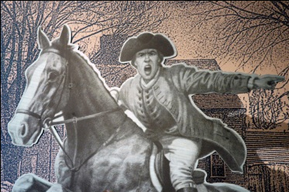Revolutionary Revelations
Year in Review: 2008

Through December 24, BU Today is looking back at the mostpopular stories of the year. We’ll be back with new stories for the newyear on Monday, January 5. Happy holidays!
Every Fourth of July, Americans celebrate, with parades, concerts, and fireworks, the events that set our nation free from colonial rule. It’s festive and it’s fun, but according to Peter Drummey, a librarian at the Massachusetts Historical Society, much of what we believe is false: 231 years later, our commonly accepted versions of revolutionary events are often more myth than fact.
Does it matter? Howard Zinn, a College of Arts and Sciences professor emeritus of political science and the author of A People’s History of the United States: 1492–Present, says that sometimes it does and sometimes it doesn’t.
“It’s not that important if we are given false information about trivial facts unless that leads us to ask about false information about important facts,” he says. “The greatest failure in teaching history is not in teaching false details, but in omitting important truths which a citizen should have in order to be an intelligent, critical participant in history.”
Drummey is similarly tolerant of history’s inaccuracies. “Legends,” the historian says, “are part of our country’s history too.”
For Drummey, part of the fun in being a historian is distinguishing fact from fiction. At the request of BU Today, he did just that, setting straight five common Fourth of July misconceptions.
1. Independence was declared on July 4, 1776.
America’s independence was actually declared by the Second Continental Congress on July 2, 1776, Drummey says. What happened on the Fourth? “That’s when the declaration was publicly announced,” he says. “And the printings of the Declaration of Independence are indeed dated July 4, 1776, because that’s when the first copy was published. But the actual vote took place on July 2.”
2. The Declaration of Independence was signed on July 4, 1776.
Actually, according to Drummey, there was never an official signing, and the closest thing to one was a group signing that took place on August 2. In fact, he says, the names of the signers were not released publicly until January 1777, when a Baltimore print shop proprietor named Mary Goddard printed a copy that included all of the signatures. “There has been speculation whether the signers wanted their names to appear on a document that was clear proof of rebellion,” Drummey says. “But by 1777, after the battles of Trenton and Princeton took place, the American cause seemed more hopeful, and that’s when they published the document with everyone’s name on it.”
What about John Trumbull’s famous painting of the signing, showing John Adams, Roger Sherman, Thomas Jefferson, and Benjamin Franklin standing in front of John Hancock, the president of the Continental Congress, with a group of other signers sitting to the left? Complete fiction, says Drummey, pointing out that the painting was commissioned in 1817.
3. The Liberty Bell is so named because it rang in American independence.
“The Liberty Bell may very well have been rung to announce the Declaration of Independence,” Drummey says, “because back then bells were used to announce any number of things — fires or emergencies or weddings. However, the bell was named by abolitionists, who adopted the Liberty Bell’s image as a symbol of the antislavery movement.”
Also, he says, the famous crack in the Liberty Bell, which is said to have happened on July 4, existed long before 1776.
4. Betsy Ross sewed the first American flag.
Everyone knows that Betsy Ross sewed the first American flag, and some of us know that the design was based on a sketch given to her by George Washington himself, right? Wrong and wrong again, says Drummey.
“We do know that Betsy Ross was a real person who lived in Philadelphia and sewed flags for the state government,” he says. “But the idea that she made the first flag didn’t publicly appear for another 100 years. A lot of these stories of the Revolution became popular around the centennial celebration, and members of her family likely passed down the story. It’s a wonderful story, most certainly, but that’s all it is.”
5. Paul Revere single-handedly warned Samuel Adams and John Hancock of the British army’s approach to Concord.
Henry Wadsworth Longfellow’s poem “Paul Revere’s Ride” has been memorized by generations of schoolchildren. That may explain, Drummey suggests, why Revere’s role in American history is so misunderstood. In the poem, Revere arrives in Concord at 2 a.m., but in reality, he was detained by the British at a roadblock in Lincoln on the way to nearby Concord. The famous poem also neglects to mention William Dawes and Samuel Prescott, two other riders who warned local militia that the British were coming.
“People read this poem and think they’re reading a historical narrative, when in fact they’re reading a celebratory poem,” Drummey says. “Revere himself never made those claims. He admitted he was captured on his way from Lexington to Concord.”
It’s necessary to remember, he continues, that Longfellow wrote his poem during events leading up to the Civil War, and he was using Revere as an example. “In times of political unrest, it is necessary to call people to action,” he says. “Revere came to symbolize an American hero during a time that America really needed one.”
Vicky Waltz can be reached at vwaltz@bu.edu.
This story originally ran July 3, 2007.